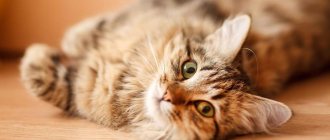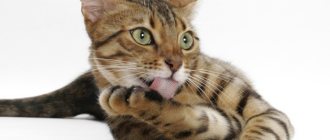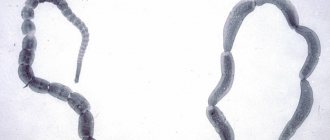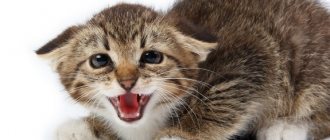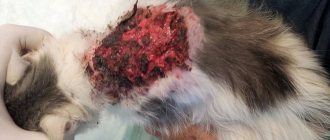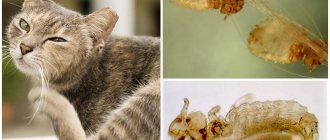Features of operation
The digestive tract in cats consists of the mouth, esophagus, stomach, small and large intestines. The digestive function is also provided by the liver with the gallbladder and the pancreas. In general, the structure of the gastrointestinal tract in cats is very similar to that of humans. However, there are some differences.
First of all, this concerns the stomach. In cats, it is single-chambered and represents an extension of the digestive tube. Hair and other foreign bodies often accumulate in this section. Cats' intestines are shorter than those of humans. Its length is on average 1–1.8 m. This is due to the feeding habits of cats, because by nature they are predators.
Treatment of cats and kittens for diarrhea at home
global $ads_google; //data-ad-slot=”2475549904″ $ads_google = empty($ads_google) ? false : true; ?> if ($ads_google == false) {?>
$ads_google = true; ?> } ?>
First of all, don't panic. You should especially not start worrying if the animal is vaccinated and has not come into contact with dubious feline personalities. We remember that the main thing is to assess the condition and find out the causes of diarrhea in a cat .
You should be aware that home treatment with proper nutrition may not be effective in serious cases. Such severe ailments require medical intervention. However, there are a number of medications that are effective in treating the symptoms of bowel disorders, some of which are used in human treatment.
Signs of violations
The main clinical symptoms depend on which organ is affected:
- Stomach. The main symptom is nausea and vomiting. If there is severe vomiting, there may be signs of dehydration.
- Small intestine. In this case, diarrhea will be most severe. With a chronic process, there may be signs of digestive insufficiency (weight loss, hair loss, lethargy).
- Colon. The main symptom of damage to the large intestine is blood or mucus in the stool, constipation.
Additional symptoms vary depending on the cause of the disease.
If the pathology is infectious in nature, then the cat will have a fever, a lethargic state, and may have catarrhal inflammation of the upper respiratory tract (nasal discharge, cough).
In case of oncological pathology, nonspecific symptoms of intoxication may additionally occur: lethargy, significant weight loss, weakness, refusal to eat.
Something else interesting: Rules for choosing a veterinary clinic
Pathologies of bacterial origin
Bacterial diseases occupy second place after viral infections in terms of danger. The only main difference is that there is no specific treatment for viral infections other than vaccinations. Bacterial diseases are treated with antibiotic therapy. But the danger from pathogenic microflora is no less than from a viral infection. The main bacterial diseases in cats are:
Hemobartonellosis
. A bacterial disease, also called infectious anemia. It is found exclusively in representatives of the cat family. The causative agent of the disease is Hemobartonella felis, which attacks red blood cells in the body, parasitizing on their surface. As a result of damage to red blood cells, a sharp drop in hemoglobin in the blood occurs. A sick pet will experience yellowness of the visible mucous membranes and the appearance of blood in the urine. Symptoms of hemobartonellosis are expressed in severe lethargy of the animal and refusal to eat. In some cases, an increase in body temperature, kidney and liver failure, and disruption of the heart and spleen are noted.
Leptospirosis
. The infection rarely affects domestic cats, but since the disease is acute, natural, focal and dangerous even for humans, the risk of infection for a cat is quite high. The vast majority of the disease affects young and weak animals that have become infected with Leptospira from raw meat or when the integrity of the skin is damaged during fights with other animals. Infection can also occur when a cat eats rodents, which are carriers and reservoirs for Leptospira. Weil's disease is accompanied by weakness of the pet, decreased appetite and damage to the digestive tract.
Salmonellosis
. A common bacterial infection caused by microorganisms of the genus Salmonella. Infection of a domestic animal occurs through the nutritional route by eating unprocessed, thermally contaminated foods, as well as meat of wild birds. Salmonellosis is characterized by symptoms such as inflammation of the stomach and intestines, profuse diarrhea (sometimes with blood and mucus), severe exhaustion of the animal, and increased body temperature. In case of infection, antibiotics are used for cats, selected individually after laboratory tests and bacterial cultures confirming salmonellosis.
Staphylococcosis
. The disease is caused by pathogenic bacteria of the genus Staphylococcus. It can occur as an independent disease, but it can also accompany viral infections, complicating the course of the pathology. There are a number of staphylococci that are opportunistic and constantly inhabit the skin of the animal. With a sharp decrease in immunity, the infection is activated, increased growth and reproduction of staphylococci begins, causing serious complications. Symptoms of staphylococcal infection depend on the location of the pathogenic microflora and the health status of the animal. May manifest as an intestinal infection, pyoderma, abscess or cellulitis.
Major diseases
All diseases of the digestive tract are divided into infectious (colitis, coronavirus enteritis, gastritis) and non-infectious (constipation, cancer, intestinal obstruction, peptic ulcer, malabsorption syndrome). Let's take a closer look at each disease.
Colitis
Colitis is a disease characterized by inflammation of the large intestine. There are several reasons that lead to the development of the disease:
- Viral or bacterial inflammation.
- Parasitic infestations.
- Damage to the intestinal mucosa by a foreign body.
- Dietary disorder.
Clinically, colitis is manifested by local inflammation in the intestines (secretion of mucus and blood with feces, painful sensations) and intoxication syndrome (lethargy, refusal to eat and play, constant drowsiness).
Constipation
Constipation is a fairly common problem in cats. In this case, the pet rarely defecates; feces remain in the intestinal cavity for a long time and lead to intoxication.
Coronavirus enteritis
Coronavirus enteritis is an inflammation of the small intestine that occurs when exposed to a virus. The disease is infectious in nature and is transmitted by the fecal-oral route. A pet can become infected from sick cats that shed the virus in their feces. Kittens and older pets are more likely to get sick.
Gastritis
Gastritis is a disease characterized by inflammation of the gastric mucosa. The following reasons can lead to the development of gastritis:
- Poisoning (both chemicals and food).
- Dietary disorder (consumption of inappropriate foods).
- Hairball in the stomach.
- Taking certain medications.
- Allergic reaction.
Gastritis can occur in two forms: acute and chronic.
Bowel cancer
Colon cancer is uncommon in cats. It is a malignant tumor that is prone to unlimited growth and metastasis.
It is quite difficult to detect a tumor in the initial stage; most often it is an accidental discovery.
In the later stages, intestinal cancer is manifested by a significant decrease in body weight, lethargy, and apathy. Often, a cat is bothered by constipation and bleeding in the feces.
The prognosis in most cases is unfavorable, but depends on the detected stage and nature of the tumor.
Obstruction
Intestinal obstruction is an acute emergency pathology that, if not intervened in time, leads to death.
Something else interesting: Vomiting in cats and what to do if your cat vomits
The reasons that lead to the development of obstruction are as follows:
- foreign body;
- intussusception;
- adhesive disease;
- compression by tumor.
The disease can occur in two forms: complete or partial obstruction. Symptoms appear acutely: paroxysmal pain, vomiting, lack of passage of stool and gas.
Peptic ulcer
Peptic ulcer is a pathology of the stomach or duodenum in which ulcers form on the mucous membrane.
There are several reasons why the disease may develop:
- Infectious agents (including helminths).
- Taking certain medications.
- Reduced protective properties of the mucous membrane.
Peptic ulcer disease is a chronic disease, so periods of exacerbation alternate with periods of remission. All symptoms appear in the acute phase: severe pain, signs of gastrointestinal bleeding (vomiting “coffee grounds”, blood in the stool).
Malabsorption
Malabsorption is a condition characterized by impaired absorption of nutrients in the intestine. Malabsorption can occur for several reasons:
- Impaired secretion or function of digestive enzymes (diseases of the pancreas, gall bladder).
- Malabsorption in the small intestine (enteritis).
- Dysbacteriosis.
Clinically, malabsorption is manifested by prolonged diarrhea (sometimes foamy), an increase in the volume of excreted feces, weight loss (due to insufficient intake of nutrients), signs of hypoproteinemia and hypovitaminosis.
Viral infections in cats
Viral infections in cats lead to serious illnesses, often causing death. A pet can get an infection not only from a sick animal, but also from virus carriers, animals without obvious signs of the disease, but which are carriers of the virus, releasing it into the environment through feces, urine, discharge from the nasopharynx and ulcers.
In epizootology, there are a large number of different viral microorganisms, but the most common among the cat family are the following:
Rabies
. An acute viral disease, which occurs with great complications, affects the nervous system and in the vast majority of cases causes the death of the animal. The rabies virus belongs to the Myxovirus family and is a zooanthropozoonosis (infection occurs as in all warm-blooded animals, as well as humans). The main source of rabies is wild animals (foxes, wolves, jackals), as well as stray cats and dogs. When a rabid animal bites, the virus penetrates the skin along with saliva. The incubation period is from 3 to 6 weeks, and in small kittens no more than 5 days. It is noteworthy that in an animal 8 days before the onset of characteristic symptoms, the rabies virus can be detected in the saliva. The possibility of infection from cats to humans should not be excluded, even with an atypical form of the disease (the animal does not show aggression, but, on the contrary, becomes too affectionate).
Calcivirosis
. An acute infectious viral disease is characterized by fever and damage to the respiratory tract. Animals with strong immune defenses develop stable immunity after suffering a calcivirus infection. The causative agent of the disease is a member of the family Caliciviridae, which is resistant to temperature. The source of infection is sick animals that release pathogenic microorganisms into the environment along with feces, secretions from the nasal cavities and oral cavity. The period from the penetration of the pathogen into the body until the onset of the first characteristic signs is from 2 to 5 days. Calicivirus infection of cats occurs with similar symptoms to rhinotracheitis, but a distinctive feature is the formation of ulcerative lesions on the tongue, soft palate, and the outer part of the nose. Often accompanied by the development of acute rhinitis, pneumonia and damage to the bronchial tree.
Panleukopenia
or
parvovirus infection
in cats. A disease often called infectious gastroenteritis or plague. A highly contagious disease, accompanied by febrile conditions in cats, functional disorders of the digestive tract (diarrhea, eruption of gastric contents), myocardial and vascular insufficiency. In the vast majority of clinical cases, it causes the death of both young and adult cats. The causative agent is parvovirus, which has a certain seasonality in outbreaks of the disease. Despite the fact that the infection affects all cats, the most susceptible are young animals and kittens, due to the body’s insufficiently developed immune defense. Sick cats and those who have recently recovered from the disease act as a source of viral disease. Along with excrement and gastric effusions, parvovirus is released into the environment. The incubation period ranges from 2 to 10 days. Characteristic signs of infectious gastroenteritis are the animal's apathy, a sharp deterioration in the condition, a rise in temperature (febrile states), vomiting and diarrhea. As the disease progresses, mucus and streaks of blood appear in the stool and gastric contents.
Viral rhinotracheitis
. A disease caused by a virus from the Herpesviridae family. A common viral infection that affects cats regardless of breed and age. Characteristic features of the course of the infection are damage to the nasopharynx, upper respiratory tract and eyes. The source of infection is sick and recovered cats that carry the virus for 9 months after recovery. The release of a pathogenic microorganism into the environment occurs with any secretions of the body (discharge from the genitals, nose and oropharynx, sperm and feces). Herpesvirus infection easily penetrates into the milk of a nursing cat, which leads to infection of newborn kittens.
Infectious feline peritonitis
. The scourge of catteries and multi-pet owners. Less commonly, cats that are the only members of the feline family are at risk of infection. Intestinal infection in cats is caused by a virus belonging to the Coronavirus family. The danger of infectious feline peritonitis is that it is quite difficult to identify in advance the type of coronavirus that leads to severe consequences. The vast majority of coronavirus infections cause digestive upset in kittens (rarely when the animal dies). But the infectious peritonitis virus is deadly. The period from the penetration of foreign microorganisms into the animal’s body until the onset of characteristic symptoms is from 2 to 3 weeks. The pathogen is released through feces, urine, blood, discharge from the eyes, mouth and nasal cavity.
Rotavirus infection in cats
. An infection caused by an RNA virus from the Rotavirus family. Capable of affecting the digestive tract, especially showing tropism for the tissue structures of the small intestine. The incubation period ranges from 20 hours to 4 days. Small kittens are more often affected by the disease, and death is also observed in kittens, although quite rarely (if the baby is unusually weak). Adult cats are sick for about 7 days. Characteristic symptoms of rotavirus infection in cats are pain in the abdominal organs, fever and frequent eruptions of gastric contents, profuse diarrhea with mucus and, in some cases, blood. If not treated promptly, the animal may suffer from dehydration.
How to act as an owner
If you notice symptoms of intestinal damage in your cat, you should contact your veterinarian for medical help. It is quite difficult to determine on your own what kind of disease your pet has and prescribe the appropriate treatment. The veterinarian will carefully examine the pet, prescribe additional examinations, and make a diagnosis. And only after this it will be possible to determine which medications are indicated for the cat. In some cases, surgery is necessary.
If your cat has severe vomiting and diarrhea, it is necessary to protect it from dehydration before contacting a veterinarian. To do this, let your cat drink in small portions, but often.
Treatment of enteritis
Treatment of enteritis in cats begins with a starvation diet. A sick pet is not fed for the first 24 hours, providing free access to clean drinking water. Obvious signs of dehydration in a cat require the administration of special solutions in addition to water. A few days after the start of treatment, the cat is given boiled oatmeal, which has an enveloping effect. This allows you to speed up the process of regeneration of damaged intestinal walls, and also improves the motility of the intestinal tract.
If the animal is recovering, you can add small portions of minced meat to the diet. Experts recommend treating enteritis in cats with intestinal lavage. For these purposes, castor oil or Glauber's salt are widely used (it all depends on the type of inflammation). If an animal suffers from severe diarrhea, astringents are prescribed and the patient's condition is monitored.
If there is no improvement for several days (diarrhea does not go away and body temperature remains high), the doctor prescribes a course of antibiotic therapy to prevent the development of complications due to pathogenic bacterial microorganisms. The dosage and type of drug are prescribed by a specialist.
In the case of viral enteritis, therapy with antiviral agents is carried out, and immunomodulatory agents are also prescribed to maintain the body's defenses. Diagnosed hemorrhages in a cat in the digestive tract are treated by administering hemostatic drugs based on vitamin K.
Vitamin therapy is also indicated to speed up the process of recovery of the body and general regeneration of damaged intestinal tissue structures. You can treat a cat at home, but only under the strict supervision of the attending physician, following his recommendations.
Pathogenic properties
Pathogenic symptoms caused by these diarrheagenic E. coli may be due to toxin production or other virulence traits. Extended-spectrum β-lactamases (ESBLs) from E. coli have also been reported.
Pyometra in a dog as a result of endometrial infection with E. coli [1] (Figure).
Several assays are available to detect diarrheagenic E. coli
, including biochemical reactions, serotyping and phenotypic assays based on virulence characteristics. However, molecular detection by PCR has become a common method for detecting and identifying these bacteria as this method provides fast and reliable results in addition to its high sensitivity and specificity.
Certain strains of E. coli behave as pathogens in dogs, causing gastrointestinal and extravascular diseases.
Causes of the disease
Infection with Escherichia coli and the manifestation of colibacillosis in pets occurs with reduced immunity and the negative influence of external factors.
The main causes of disease in cats:
- contact with a sick animal and its excrement;
- drinking contaminated water and food;
- transmission of bacteria during birth to kittens from the mother;
- unsanitary conditions for keeping animals;
- feeding with prepared food produced with technological violations;
- consumption of thermally unprocessed natural products;
- eating infected rodents;
- infectious processes in the body.
Prognosis for cats with VKD
Inflammatory bowel disease can only be controlled, not cured. Usually the prognosis in cases of severe illness is poor.
Be patient with the form of treatment suggested by your veterinarian and strictly adhere to the recommendations. Control depends on the correct selection of diet, dosages of medications, careful monitoring by the veterinarian and owner, and the absence of other concomitant diseases.
Read reviews about our veterinary center. Call the number and schedule a consultation right now or request a call back. (c) Veterinary center for the treatment and rehabilitation of animals “Zoostatus”. Varshavskoe highway, 125 building 1.
It is a well-known fact that cats see very well in the dark.
Urolithiasis is a fairly common occurrence in cats. Given this.
It has long been a known fact that cats have sharper hearing than humans. But.
Scientists conducted an experiment in which they studied the reaction of the domestic organism.
Archaeologists have been finding the position of the Ancient One at the site for hundreds of years.
Clinical picture
Viral intestinal diseases manifest themselves quickly and “vividly”, in the form of severe, profuse diarrhea. Most often, stool is watery, faded or greenish. The characteristic “stroke” is a disgusting odor that develops when the affected intestinal epithelium begins to literally “slide” from the walls of the digestive organs. If the cat is young and strong enough, there may be no clinical signs. Again, the symptoms in kittens are more than obvious:
- Rapid, progressive weight loss.
- Complete or partial lack of appetite.
- Pain in the abdomen, when you try to feel it, the cat either resists or tries to run away, simultaneously howling and scratching people within reach.
- Dehydration.
- Fever of a constant or intermittent type.
- Vomit. A very alarming symptom indicating the development of severe intoxication in the animal.
- Sneezing.
- Cloudy discharge from the eyes.
- Sudden onset of rhinitis.
Therapeutic techniques
Alas, viruses are unpleasant “types”. Only in some cases is there specific therapy: if the type and strain of the pathogen is known exactly , autoimmune serums are of great help. But such a subtle analysis as determining the species of a virus cannot always be performed and not everywhere. So therapy is symptomatic.
Dehydration is relieved by intravenous administration of buffer compounds, sedatives, analgesics and antipyretics are administered to alleviate the pet’s general condition. To help the cat’s body cope with the virus, veterinarians often use regular (human) interferon. Antibiotics are also used , but their goal is not to destroy the pathogen (viruses are completely insensitive to them), but to prevent the development of secondary bacterial infections caused by pathogenic and conditionally pathogenic microflora.

